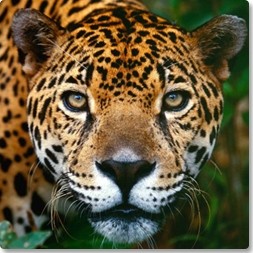
Jaguar
Panthera onca
The jaguar is the third-largest feline after the tiger and the lion, and the largest in the Western Hemisphere.
This spotted cat most closely resembles the leopard physically, although it is usually larger and of sturdier build and its behavioral and habitat characteristics are closer to those of the tiger. While dense rainforest is its preferred habitat, the jaguar will range across a variety of forested and open terrain. It is strongly associated with the presence of water and is notable, along with the tiger, as a feline that enjoys swimming. The jaguar is largely a solitary, opportunistic, stalk-and-ambush predator at the top of the food chain (an apex predator). It is a keystone species, playing an important role in stabilizing ecosystems and regulating the populations of the animals it hunts.
The jaguar is a near threatened species and its numbers are declining. Threats include habitat loss and fragmentation. While international trade in jaguars or their parts is prohibited, the cat is still frequently killed by humans, particularly in conflicts with ranchers and farmers.

Giant River Otter
Pteronura brasiliensis
Guyana's Giant River Otter is the largest of the world's 13 otter species, (the sea otter, with its more compact body, may weigh considerably more). Giant otter males attain an overall length of 1.5 to 1.8m and a weight of between 26 and 32 kg; females generally measure 1.5 to 1.7 m in length and may weigh between 22 and 26 kg. The throat and chest are usually marked with irregular cream-coloured patches or spots; the muzzle, lips and chin are often spotted white. Long and numerous facial whiskers protrude from the muzzle, forehead and temples and are believed to be highly sensitive in order to facilitate prey location in turbid waters, when vision is impaired.
Historically giant otters ranged throughout the tropical lowland rainforests and wetlands of South America. Remnant populations exist in Guyana, Suriname, and a few other countries but is considered extinct in Argentina and Uruguay. The giant river otter is an IUCN red-listed species and is considered endangered. Accelerating habitat destruction and degradation, poaching, and unmanaged tourism are likely to reduce the remaining populations by 50% over the next 20 years (three Giant Otter generations).

Giant anteater
Mymecophaga tridactyla
Anteaters are edentate animals—they have no teeth. But their long tongues are more than sufficient to lap up the 35,000 ants and termites they swallow whole each day.
The anteater uses its sharp claws to tear an opening into an anthill and put its long snout and efficient tongue to work. But it has to eat quickly, flicking its tongue up to 160 times per minute. Ants fight back with painful stings, so an anteater may spend only a minute feasting on each mound. Anteaters never destroy a nest, preferring to return and feed again in the future.
These animals find their quarry not by sight—theirs is poor—but by smell.
The giant anteater can reach 7 feet (2.1 meters) long from the tip of its snout to the end of its tail.
They are generally solitary animals. Females have a single offspring once a year, which can sometimes be seen riding on its mother's back.
Anteaters are not aggressive but they can be fierce. A cornered anteater will rear up on its hind legs, using its tail for balance, and lash out with dangerous claws. The giant anteater's claws are some four inches (ten centimeters) long, and the animal can fight off even a puma or jaguar.
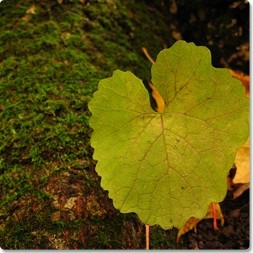
Greenheart tree
Chlorocardium rodiei
The venerable Greenheart is an evergreen tree growing to 15–30 m tall with a trunk diameter of 35–60 cm. The leaves are opposite, simple, with an entire margin. The fruit is a drupe containing a single seed.
Greenheart is listed on the IUCN Red list (1996) as Vulnerable. Between 15 and 28% of the original population has been harvested to date. Harvesting as a commercial timber began in the late 18th century, but most of the harvesting has only taken place since the introduction of chainsaws in 1967.
The wood is extremely hard and strong. So hard, in fact, that it cannot be worked with standard tools. Being extremely durable in marine conditions, Greenheart is used extensively in the building of docks and in similar applications and was an early choice for fly fishing rods.
The Fram and the Endurance, the two strongest wooden ships ever constructed and made famous in the polar expeditions of Amundsen and Shackleton, were sheathed in greenheart to prevent the ships from being crushed by ice. Greenheart wood is often sought for construction projects in parts of the Caribbean where wood-ants are seen as a problem for conventional pine wood construction.
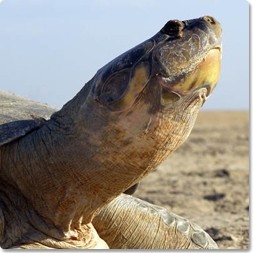
Giant River Turtle
Podocnemis expansa
The giant South American turtle is the largest river turtle in South America. It has a broad, domed and streamlined carapace for active swimming in moderate river currents. The colour may be influenced by the algae that is attached to it, but is usually olive green to brown.
The giant South American turtle inhabits freshwater rivers with sandy banks or sandbars, which are crucial for nesting. It nests during the low water season, laying from 75 to 125 leathery eggs per clutch. Large groups of females return to the same sandy riverbanks and sandbars every year to nest in groups that are thought to decrease loss of eggs to predators. As with most turtles, the sex of the hatchlings is determined by the average temperature at which they are incubated.
Threats to this species are primarily poaching for food and oil, urban and industrial development near nesting sites, and lack of conservation education. Logging and clearing of areas surrounding rivers and damming of rivers can cause the water cycle to be drastically altered which can confuse the turtles' natural seasonal nesting cycles.
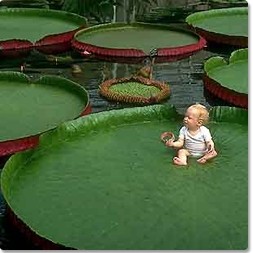
Giant lily pads
Victoria amazonica
The species has very large leaves, up to 3m in diameter which float on the water's surface on a submerged stalk, 7–8 m in length. The species was once called Victoria regia after Queen Victoria, but the name was superseded. V. Amazonia is native to the shallow waters of the Amazon River basin, such as oxbow lakes and bayous. It (flower) is the national flower of Guyana and is depicted in the country’s coat of arms. The flowers are white the first night they are open and become pink the second night. They are up to 40 cm in diameter, and are pollinated by beetles.
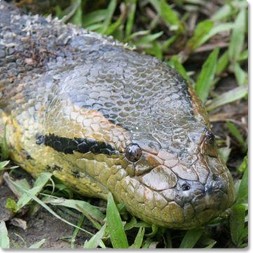
Anaconda
Eunectes murinus
Anaconda is the common name for a large South American snake of the boa family. The anaconda - or water boa - is one of the largest and most powerful snakes in the world, and the largest in the western hemisphere. It kills its prey by constriction, or squeezing.
The reptile is found in the rivers of all three Guianas (Guyana, Suriname and French Guyana) as well as Brazil and Venezuela.
Primarily aquatic, they eat a wide variety of prey including fish, birds, a variety of mammals, and other reptiles. Particularly large anacondas may even consume large prey such as tapir, deer, capybara and caiman. There are many local stories and legends regarding the anaconda as a man-eater, but there is very little evidence to support any such activity.
Cannibalism among green anacondas is also known, most recorded cases involving a larger female consuming a smaller male.
Anacondas are ovoviviparous, which means that the females carry the eggs within their bodies until the babies are ready to hatch. Then, the pregnant female can give birth to anywhere from 12 to more than 80 2-foot-long baby snakes. Young anacondas are independent as soon as they are born, but will not breed for many years.
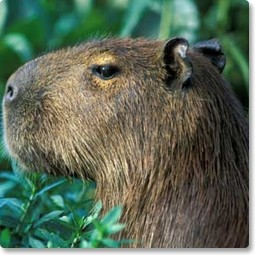
Capybara
Hydrochaeris hydrochaeris
Capybara are the largest of all the 1,729 species of living rodents. Adult capybaras may be as long as 130 centimeters (more than four feet) and 50 centimeters (1.6 feet) tall, and weigh more than 100 pounds.
The capybara is a grazing herbivore, eating 6 to 8 pounds (2.7 to 3.6 kg) of grasses per day. Capybara are very selective feeders with four to six plant species making 75% of its diet. Capybaras are coprophagous, meaning they eat their own feces as a source of bacterial gut flora and to help digest the cellulose in the grass that forms their normal diet and extract the maximum protein from their food. They may also regurgitate food to masticate again, similar to cud-chewing by a cow.
Capybara are highly social and live in groups controlled by a dominant male. They frequently dive and may remain underwater for as long as five minutes, and can sleep with just their nose breaking the surface of the water.
They can have a life span of 8-10 years in the wild but average a life less than four years as they are "a favourite food of jaguar, puma, ocelot, eagle and caiman". The capybara is the preferred prey of the anaconda.
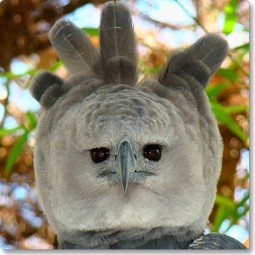
Harpy eagle
Harpia harpyja
Harpy eagles are the largest and most powerful raptor found in the Americas and among the largest raptor species in the world.
The harpy has a wingspan of 2 meters (6.5 feet), a body length of 90-105 cm (3-3.5 feet), and weighs 10 - 20 pounds. The female can be twice as heavy as her mate.
Harpies are found in tropical lowland forests ranging from southeastern Mexico to northern Argentina and southern Brazil, with regular sightings in Guyana and Suriname. This bird prefers large expanses of uninterrupted forest, but will hunt in open areas adjacent to forest patches. They feed primarily on animals that live in the trees, like sloths, monkeys, opossums, and some reptiles and birds.
Harpy eagles build huge nests of sticks and branches in the tallest trees. Eggs take 53-58 days to hatch, with the chick fledging in 4.5 - 6 months. Juveniles stay in the parent's territory for at least a year.
The scientific name comes from the Greek word harpe referring to a bird of prey mentioned by Aristotle, Pliny, and other Greek scholars.